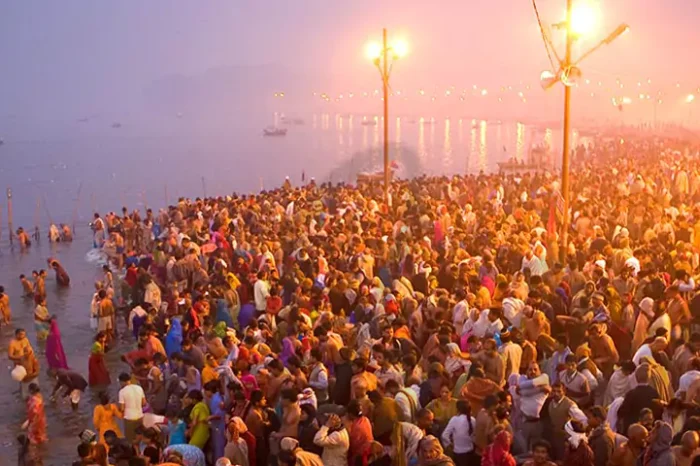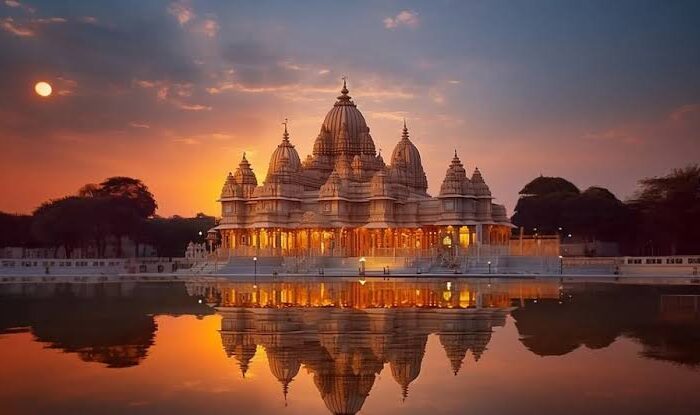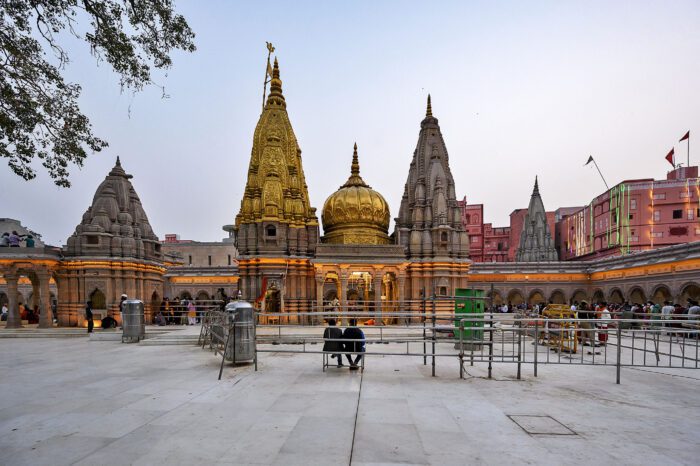Prayagraj
Related Tours

5 Days, 6 Nights Itinerary: Prayagraj, Ayodhya, and Kashi (Varanasi)
This itinerary is designed for international tourists, offering a spiritual journey through significant pilgrimage sites in India, including Prayagraj, Ayodhya, and Kashi, while also allowing for cultural exploration.

5 Days, 6 Nights Mathura-Vrindavan-Agra-Ayodhya-Kashi Itinerary (Lucknow to Lucknow)
This itinerary is designed for travelers starting and ending their journey in Lucknow, covering the holy cities of Mathura, Vrindavan, Agra, Ayodhya, and Varanasi (Kashi)

5 Days, 6 Nights Mathura-Vrindavan-Agra-Ayodhya-Kashi Itinerary (Delhi to Delhi)
This itinerary is perfect for travelers looking to experience a blend of spiritual and cultural exploration in Mathura, Vrindavan, Agra, Ayodhya, and Varanasi (Kashi), starting and ending in Delhi. This covers major Hindu pilgrimage sites …
### Historical Significance of Prayagraj Prayagraj, formerly known as Allahabad, is a city in Uttar Pradesh, India, located at the confluence of the Ganges, Yamuna, and the mythical Sarasvati rivers. This sacred site, known as **Triveni Sangam**, has been revered […]
### Historical Significance of Prayagraj
Prayagraj, formerly known as Allahabad, is a city in Uttar Pradesh, India, located at the confluence of the Ganges, Yamuna, and the mythical Sarasvati rivers. This sacred site, known as **Triveni Sangam**, has been revered in Hindu tradition for centuries. The name “Prayagraj” means “the king among the five prayāgas,” highlighting its prominence among sacred confluences in India.
#### Ancient Origins
The history of Prayagraj dates back to ancient times, with references found in Hindu texts such as the **Vedas** and **Puranas**. It is believed that the city was a significant site for rituals and sacrifices, particularly associated with **Brahma**, the creator deity in Hinduism. Archaeological excavations indicate that the area was inhabited as early as 600 BCE, with findings such as Northern Black Polished Ware suggesting a developed civilization existed there during the Iron Age[1][2].
### Mughal Era and City Foundation
The modern city of Prayagraj was founded in **1583** by Mughal Emperor **Akbar**, who recognized its strategic location. He constructed a fort and named the city **Ilahabad**, which means “City of God,” reflecting both Hindu and Islamic influences. Akbar’s establishment of this city was partly motivated by its significance as a pilgrimage site, where he aimed to facilitate the movement of pilgrims and collect taxes from them[1][3][4].
### Kumbh Mela: A Major Pilgrimage Festival
The **Kumbh Mela** is one of the largest religious gatherings globally, held every 12 years at four locations: Prayagraj, Haridwar, Ujjain, and Nashik. The festival is deeply rooted in Hindu mythology, believed to have originated from the myth of the churning of the ocean (Samudra Manthan), where drops of nectar (amrit) fell at these locations.
#### Rituals and Significance
During the Kumbh Mela, millions of devotees gather to take ritual baths at the Sangam, believing it purifies their sins and grants them salvation. The festival includes various religious activities such as prayers, cultural performances, and spiritual discourses. The most auspicious bathing days during Kumbh are known as **Shahi Snan**, where prominent saints and devotees participate[3][4].
### Modern Developments
In recent years, Prayagraj has seen significant changes, including a name change from Allahabad to Prayagraj in 2018, reflecting a resurgence of cultural identity. The city continues to serve as an important administrative and educational center while maintaining its status as a major pilgrimage destination[1][3][5].
### Conclusion
Prayagraj’s rich history intertwines with its role as a spiritual hub through events like the Kumbh Mela. Its ancient roots, historical developments under various empires, and ongoing significance in Hindu culture make it a unique city that embodies both religious devotion and historical depth.
## Prayagraj Maha Kumbh 2025 Overview
The **Maha Kumbh Mela** in Prayagraj, scheduled for **2025**, is one of the largest religious gatherings in the world, attracting millions of pilgrims. This event occurs every 12 years, with the next one set to begin on **January 13, 2025**, and concluding on **February 26, 2025**.
### Key Dates and Events
– **Start Date**: January 13, 2025 (Pausha Purnima)
– **Shahi Snan Dates**:
– January 14, 2025: Makar Sankranti
– January 29, 2025: Mauni Amavasya
– February 3, 2025: Vasant Panchami
– **Other Significant Dates**:
– February 12, 2025: Maghi Purnima
– February 26, 2025: Mahashivaratri
### Notable Preparations
The **Panch Dashnam Juna Akhara**, a prominent group of ascetics, has outlined several key activities leading up to the Kumbh:
– **October 12, 2024**: Departure of ascetics to Prayagraj.
– **November 3, 2024**: Grand procession (Peshwai) into the Kumbh area.
– **December 14, 2024**: Rituals and ceremonies led by Akhara leaders.
### Venue Layout
Preparations for the Kumbh Mela are extensive. The layout for the Kumbh city has been finalized, consisting of **25 sectors**, with a significant portion located in the Jhunsi area. This setup aims to accommodate the expected influx of devotees and ensure efficient management of facilities and services[1][2][5].
### Cultural Significance
The Maha Kumbh Mela is rooted in Hindu mythology, believed to cleanse sins and provide liberation from the cycle of birth and death. The festival’s importance is underscored by its historical context and the massive participation it garners from across India and beyond[2][4].
### Conclusion
As preparations intensify for the Maha Kumbh Mela in Prayagraj, the event promises to be a significant spiritual gathering filled with rituals, cultural displays, and communal harmony. Pilgrims are encouraged to plan their visits around the key bathing dates to fully experience this sacred occasion.
Share this tour
-

We offers affordable, safe, and hassle-free pilgrimage experiences to divine destinations in North India. We take the stress off your shoulders, planning and organizing every detail of your trip—covering travel, stay, and meals to ensure a peaceful and well-organized spiritual journey
Contact Info
Office ; 78, Third Floor SRGP Mall, Tatmil, Kanpur
208004Mon – Sat 8.00 – 20.00 Sunday CLOSED
Find us